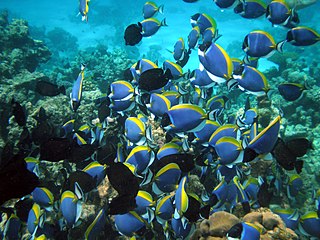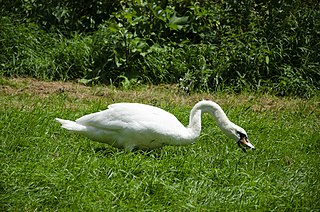Related Research Articles

Hummingbirds are birds native to the Americas and constituting the biological family Trochilidae. They are the smallest of birds, most species measuring 7.5–13 cm (3–5 in) in length. The smallest extant hummingbird species is the 5 cm (2.0 in) bee hummingbird, which weighs less than 2.0 g (0.07 oz). The largest hummingbird species is the 23 cm (9.1 in) giant hummingbird, weighing 18–24g (0.63–0.85 oz).

Foraging is searching for wild food resources. It affects an animal's fitness because it plays an important role in an animal's ability to survive and reproduce. Foraging theory is a branch of behavioral ecology that studies the foraging behavior of animals in response to the environment where the animal lives.

A birdfeeder, bird feeder, bird table, or tray feeder are devices placed outdoors to supply bird food to birds. The success of a bird feeder in attracting birds depends upon its placement and the kinds of foods offered, as different species have different preferences.

The giant hummingbird is the only member of the genus Patagona and the largest member of the hummingbird family, weighing 18–24 g (0.63–0.85 oz) and having a wingspan of approximately 21.5 cm (8.5 in) and length of 23 cm (9.1 in). This is approximately the same length as a European starling or a northern cardinal, though the giant hummingbird is considerably lighter because it has a slender build and long bill, making the body a smaller proportion of the total length. This weight is almost twice that of the next heaviest hummingbird species and ten times that of the smallest, the bee hummingbird.

A herd is a social group of certain animals of the same species, either wild or domestic. The form of collective animal behavior associated with this is referred to as herding.
A nectar source is a flowering plant that produces nectar as part of its reproductive strategy. These plants create nectar, which attract pollinating insects and sometimes other animals such as birds.

Optimal foraging theory (OFT) is a behavioral ecology model that helps predict how an animal behaves when searching for food. Although obtaining food provides the animal with energy, searching for and capturing the food require both energy and time. To maximize fitness, an animal adopts a foraging strategy that provides the most benefit (energy) for the lowest cost, maximizing the net energy gained. OFT helps predict the best strategy that an animal can use to achieve this goal.

Ornithophily or bird pollination is the pollination of flowering plants by birds. This sometimes coevolutionary association is derived from insect pollination (entomophily) and is particularly well developed in some parts of the world, especially in the tropics, Southern Africa, and on some island chains. The association involves several distinctive plant adaptations forming a "pollination syndrome". The plants typically have colourful, often red, flowers with long tubular structures holding ample nectar and orientations of the stamen and stigma that ensure contact with the pollinator. Birds involved in ornithophily tend to be specialist nectarivores with brushy tongues and long bills, that are either capable of hovering flight or light enough to perch on the flower structures.

Bird food or bird seed is food, typically varieties of seeds, nuts, or dried fruits eaten by birds. While most bird food is fed to commercial fowl, people also use bird food to feed their pet birds or wild birds.
In ecology, an ideal free distribution (IFD) is a theoretical way in which a population's individuals distribute themselves among several patches of resources within their environment, in order to minimize resource competition and maximize fitness. The theory states that the number of individual animals that will aggregate in various patches is proportional to the amount of resources available in each. For example, if patch A contains twice as many resources as patch B, there will be twice as many individuals foraging in patch A as in patch B.

Gleaning is a feeding strategy by birds in which they catch invertebrate prey, mainly arthropods, by plucking them from foliage or the ground, from crevices such as rock faces and under the eaves of houses, or even, as in the case of ticks and lice, from living animals. This behavior is contrasted with hawking insects from the air or chasing after moving insects such as ants. Gleaning, in birds, does not refer to foraging for seeds or fruit.

In ethology and behavioral ecology, trap-lining or traplining is a feeding strategy in which an individual visits food sources on a regular, repeatable sequence, much as trappers check their lines of traps. Traplining is usually seen in species foraging for floral resources. This involves a specified route in which the individual traverses in the same order repeatedly to check specific plants for flowers that hold nectar, even over long distances. Trap-lining has been described in several taxa, including bees, butterflies, tamarins, bats, rats, and hummingbirds and tropical fruit-eating mammals such as opossums, capuchins and kinkajous. Traplining is used to term the method in which bumblebees and hummingbirds go about collecting nectar, and consequently, pollinating each plant they visit. The term "traplining" was originally coined by Daniel Janzen, although the concept was discussed by Charles Darwin and Nikolaas Tinbergen.

In biology, any group of fish that stay together for social reasons are shoaling, and if the group is swimming in the same direction in a coordinated manner, they are schooling. In common usage, the terms are sometimes used rather loosely. About one quarter of fish species shoal all their lives, and about one half shoal for part of their lives.

Flower constancy or pollinator constancy is defined as the tendency of individual pollinators to exclusively visit certain flower species or morphs within a species, bypassing other available flower species that could potentially be more rewarding. Flower constancy is different from other types of insect specialization such as innate preferences for certain colors or flower types, or the tendency of pollinators to visit the most rewarding and abundant flowers.
The National Bird-Feeding Society (NBFS) is an organization in the United States whose mission is to make the hobby of bird feeding better, both for people who feed wild birds and for the birds themselves. To fulfill its mission, the NBFS conducts research and promotes education on wild bird feeding

Frequency-dependent foraging is defined as the tendency of an individual to selectively forage on a certain species or morph based on its relative frequency within a population. Specifically for pollinators, this refers to the tendency to visit a particular floral morph or plant species based on its frequency within the local plant community, even if nectar rewards are equivalent amongst different morphs. Pollinators that forage in a frequency-dependent manner will exhibit flower constancy for a certain morph, but the preferred floral type will be dependent on its frequency. Additionally, frequency-dependent foraging differs from density-dependent foraging as the latter considers the absolute number of certain morphs per unit area as a factor influencing pollinator choice. Although density of a morph will be related to its frequency, common morphs are still preferred when overall plant densities are high.
Episodic-like memory is the memory system in animals that is comparable to human episodic memory. The term was first described by Clayton & Dickinson referring to an animal’s ability to encode and retrieve information about ‘what’ occurred during an episode, ‘where’ the episode took place, and ‘when’ the episode happened. This ability in animals is considered ‘episodic-like’ because there is currently no way of knowing whether or not this form of remembering is accompanied by conscious recollection—a key component of Endel Tulving’s original definition of episodic memory.
Vigilance, in the field of behavioural ecology, refers to an animal's examination of its surroundings in order to heighten awareness of predator presence. Vigilance is an important behaviour during foraging as animals must often venture away from the safety of shelter to find food. However being vigilant comes at the expense of time spent feeding so there is a trade-off between the two. The length of time animals devote to vigilance is dependent on many factors including predation risk and hunger.

Euglossa imperialis is a bee species in the family Apidae. It is considered to be one of the most important pollinators to many Neotropical orchid species in mainland tropical America. It is also one of the most common non-parasitic euglossine species in lowland Panama. E. imperialis, unlike many other bee species, is not a social bee in the sense that there is no apparent morphological or physiological division within the species to distinguish individual bees to be part of a worker or reproductive caste.

Avian foraging refers to the range of activities and behaviours exhibited by birds in their quest for food. In addition to their unique body adaptations, birds have a range of described behaviours that differ from the foraging behaviours of other animal groups. According to the foraging habitat, birds may be grouped into foraging guilds. Foraging includes a range of activities, starting with the search for food, making use of sensory abilities, and which may involve one or more birds either of a single or even of multiple species. This is followed by locomotion and movements to obtain or capture the food, followed by the processing or handling of the foods prior to ingestion. Like all organisms foraging entails balancing the energy spent and energy gained. The high metabolic rate of birds, among the highest in the homoeotherm groups, constrains them to ensure a net positive gain in energy and have led evolutionary ethologists to develop the idea of optimal foraging.
References
- 1 2 3 4 5 6 7 Caraco, Thomas; Martindale, Steven; Whittam, Thomas S. (1980). "An empirical demonstration of risk-sensitive foraging preferences". Animal Behaviour. 28 (3): 820–830. doi:10.1016/s0003-3472(80)80142-4.
- 1 2 3 Barnard, C. J.; Brown, C. A. J. (1985). "Risk-Sensitive Foraging in Common Shrews (Sorex araneus L.)". Behavioral Ecology and Sociobiology. 16 (2): 161–164. doi:10.1007/BF00295150. JSTOR 4599760.
- 1 2 Caraco, Thomas (1981-06-01). "Energy budgets, risk and foraging preferences in dark-eyed juncos (Junco hyemalis)". Behavioral Ecology and Sociobiology. 8 (3): 213–217. doi:10.1007/BF00299833. ISSN 0340-5443.
- ↑ Pubols, Benjamin (1962). "Constant versus variable delay of reinforcement". Journal of Comparative and Physiological Psychology: 55–52.
- ↑ Hurly, T.Andrew; Oseen, Michael D. (1999). "Context-dependent, risk-sensitive foraging preferences in wild rufous hummingbirds". Animal Behaviour. 58 (1): 59–66. doi:10.1006/anbe.1999.1130. PMID 10413541.